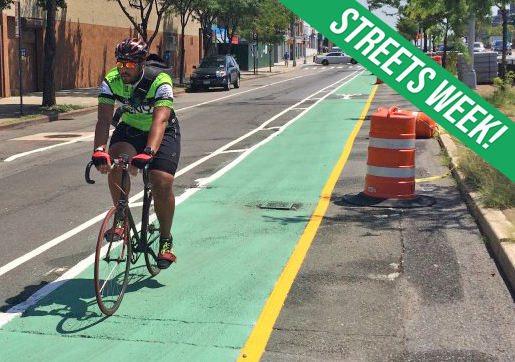Finally.
Mayor de Blasio announced on Thursday — Day Four of Streets Week! — that his administration would finish the long-delayed construction of the Queens Boulevard protected bike lane, whose final phase was originally slated for November, 2018.
In the time since that original start date and Thursday announcement, there have 354 crashes on that final stretch, which covers Yellowstone Boulevard to Union Turnpike [PDF], injuring 16 cyclists, 32 pedestrians and 73 motorists. City statistics show that injuries from crashes dropped by 24 percent and pedestrian injuries were down 55 percent after the first phase was completed between Roosevelt and Eliot avenues.
That's why the mayor was so eager to hype the announcement of the completion.
"Queens Boulevard was synonymous with the problem of horrible deaths on the road," he said, recalling why the city made the street safety project one of its original Vision Zero initiatives. "I don't have to remind people it used to be called 'the Boulevard of Death.' I knew we had to do was address Queens Boulevard. I knew it would take time, but it has had remarkable impact."
On Thursday, the mayor blamed the COVID-19 pandemic and "an issue with federal approval" for the delay of the final phase of the project, but it was his own administration that stalled. In February, 2020, just as work was finally about to begin, de Blasio put the project on hold at the behest of Forest Hills Council Member Karen Koslowitz, who opposes the bike lane. Koslowitz wanted the city to put the protected bike lane in the median of Queens Boulevard to retain a lane of the service road for parking — a design that the city had previously rejected. De Blasio said his agency decided against appeasing Koslowitz.)
"She honestly felt what she was proposing was better for her community, but we came to the conclusion that it wasn't workable and the original plan was fair," Hizzoner said. He also claimed that "we need these final approvals, but we are ready to go." (It is unclear why those "approvals" did not affect earlier phases of the project.)
More details will likely follow, but the mayor said on Thursday that construction will begin in July and the project will be finished by the end of November.
"This is crucial to a recovery for all of us — to have safety and streets that work," he said.
Sure, but advocates say that the extended timeline is an indictment of a mayor who hasn't focused enough on his own signature initiative, Vision Zero. Plus, the original Queens Boulevard project was meant to go much further east in Queens.
"It should never have taken this long in the first place to transform the Boulevard of Death,” said Danny Harris, executive director of Transportation Alternatives. “New York City is on track to have the second-deadliest year on our streets since Vision Zero began, and Mayor de Blasio and our next mayor must bring the same life-saving street designs for Queens Boulevard to corridors across the five boroughs without delay. This includes extending the project on Queens Boulevard all the way to Hillside Avenue as was initially proposed.”
One victim of the once-deadly-but-now-largely-tamed roadway praised the mayor for at least getting the job eventually and partially done.
“We feel immense relief that we can finally close the book on this corridor that has caused tragedy for too many New York families like my own,” said Lizi Rahman, a member of Families for Safe Streets and the mother of Asif Rahman, who was killed in 2008 by a reckless driver on Queens Boulevard while riding his bike. “Today’s announcement is a testament to our years of relentless organizing, and we are grateful for all of the Families for Safe Streets members who have turned their anguish into action and can celebrate this victory today.”






